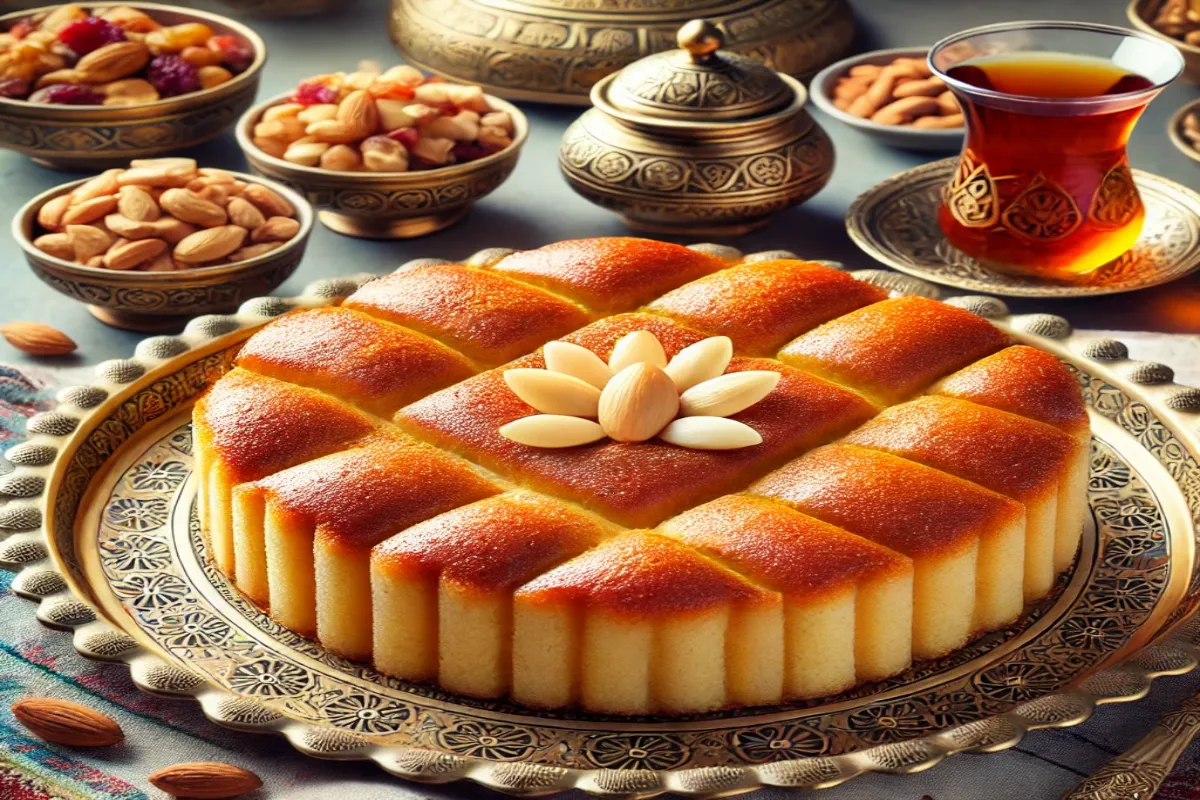Semolina cake, a cherished dessert in many cultures, offers a rich texture and delightful flavor. Popular across the Middle East, Mediterranean regions, and parts of Europe, semolina cake holds a special place in culinary traditions. But what exactly makes up this cake, and why is it so beloved?
In this article, we’ll explore the core ingredients of semolina cake, regional variations, and provide a step-by-step guide on how to make it. We will also cover common mistakes to avoid and answer frequently asked questions.
The Cultural Significance of Semolina Cake
Semolina cake isn’t just a dessert—it symbolizes celebration, hospitality, and tradition in many parts of the world. In the Middle East, for instance, families often serve cakes like Basbousa or Namoura during religious holidays, weddings, and family gatherings. These cakes bring people together, often taking center stage during festive occasions.
Mediterranean cultures treat semolina cakes like Halva with similar importance. In Greece, Halva marks both celebrations and periods of fasting, making it versatile for both joyous and somber events. Likewise, North African countries like Morocco and Algeria infuse semolina cakes with local flavors such as honey and almonds, reflecting the region’s rich culinary heritage.
By understanding the cultural backdrop of semolina cake, we can appreciate the diverse recipes and techniques across different regions. Each cake tells a story of history, rituals, and cherished memories.
What is Semolina?
The heart of semolina cake lies in semolina, a coarse flour made from durum wheat. Semolina’s high gluten content and yellow color make it ideal for baked goods that require both structure and a tender crumb. Its texture can vary; coarse semolina provides a slightly grainy mouthfeel, while fine semolina creates a smoother texture.
Semolina appears in various dishes beyond desserts, including savory items like couscous and pasta. In baking, it balances sweetness with a subtle, nutty flavor. If you’re curious about other unique ingredients like semolina, check out the bread cheese guide for more insights into versatile ingredients that can transform everyday dishes.
Core Ingredients of Semolina Cake

A traditional semolina cake typically includes just a few key ingredients. Each plays an essential role in creating the cake’s distinctive flavor and texture.
1. Semolina
Semolina forms the base of the cake, giving the dessert its signature texture. Depending on whether you use coarse or fine semolina, the texture of your cake will range from more granular to smoother.
2. Sugar
Sugar provides the sweetness that balances the earthiness of the semolina. Some recipes call for sugar to mix directly into the batter, while others apply sugar syrup to the cake after baking, enhancing its moisture and sweetness.
3. Dairy
Dairy products like yogurt, milk, or butter add richness and moisture to the cake. Yogurt, in particular, appears often in Middle Eastern recipes, as its slight tang complements the cake’s sweetness.
4. Flavorings
Traditional semolina cakes often include fragrant ingredients. The most common flavorings include rose water and orange blossom water, staples in Middle Eastern and Mediterranean desserts. Vanilla extract also offers a more familiar flavor.
5. Leavening Agents
To create a light, fluffy texture, recipes often add a small amount of baking soda or baking powder. These leavening agents help the cake rise, preventing it from becoming too dense.
6. Optional Add-ins
Many semolina cake variations include additional ingredients for flavor and texture. For example, shredded coconut appears in Basbousa, while chopped almonds, pistachios, or cashews add crunch and flavor to other variations.
7. Sugar Syrup
One hallmark of semolina cake is the sugar syrup poured over it immediately after baking. This syrup, made from sugar and water and sometimes infused with lemon juice or honey, keeps the cake moist while enhancing its sweetness. If you want to master the art of sugar syrup, this guide provides step-by-step instructions.
Popular Variations of Semolina Cake
Semolina cake comes in many forms across different regions. Each variation reflects the local flavors and traditions of the culture it comes from.
1. Basbousa
Middle Eastern Basbousa features semolina, sugar, yogurt, and coconut. After baking, the cake absorbs a syrup infused with rose water or orange blossom water, giving it a moist texture. Topping it with blanched almonds or shredded coconut adds both flavor and texture.
2. Namoura
Lebanese Namoura, similar to Basbousa, uses fewer ingredients. It features orange blossom water or rose water for flavor, and its top displays a distinctive diamond pattern. Namoura also absorbs syrup after baking, resulting in a moist, flavorful cake.
3. Halva
Greek Halva differs from its Middle Eastern counterparts. This dense, sweet semolina cake often includes cinnamon and nuts. To make Halva, toast semolina in oil or butter, which imparts a rich, nutty flavor. After baking, Halva is typically garnished with powdered sugar or cinnamon.
4. Revani
Revani, popular in Greece and Turkey, is lighter than Halva. It often features lemon zest or orange peel for flavor. After baking, Revani soaks in a citrus-infused syrup, creating a refreshing, tangy dessert.
5. Rava Cake
In India, semolina, also known as rava, becomes a fluffy, moist cake called Rava Cake. This cake, flavored with cardamom and topped with nuts like cashews or almonds, frequently serves as a tea-time snack.
6. Basbousa with Coconut
This variation of Basbousa includes shredded coconut in the batter, adding a tropical twist. The coconut balances the sweetness of the syrup, creating a rich yet refreshing dessert.
These variations show how adaptable semolina cake can be to different tastes and preferences. Whether you enjoy citrusy flavors like those in Revani or spiced treats like Halva, there’s a semolina cake for everyone.
How to Make Semolina Cake: Step-by-Step Guide
Here’s a basic recipe for making a traditional semolina cake at home:
Ingredients:
- 1 cup semolina
- 1 cup sugar
- 1 cup yogurt
- 1/4 cup butter or ghee
- 1 teaspoon baking powder
- 1 teaspoon rose water or orange blossom water
- Optional: shredded coconut, almonds, or pistachios for garnish
Instructions:
- Prepare the batter: Mix semolina, sugar, yogurt, and butter in a large bowl until smooth. Add baking powder and flavorings, then stir to combine.
- Rest the batter: Pour the batter into a greased baking dish and let it rest for about 30 minutes.
- Bake: Preheat the oven to 350°F (175°C). Bake for 30-40 minutes, or until the top turns golden brown and a toothpick inserted into the center comes out clean.
- Make the syrup: While the cake bakes, heat sugar and water in a saucepan until the sugar dissolves. Add rose water or orange blossom water for flavor.
- Pour the syrup: After removing the cake from the oven, immediately pour the warm syrup over it. Allow the cake to absorb the syrup as it cools.
- Serve: Garnish the cake with coconut or nuts, then slice it into squares or diamonds to serve.
Common Mistakes to Avoid
1. Overmixing the Batter
Overmixing can lead to a dense cake. To avoid this, mix the batter just until all the ingredients combine.
2. Using the Wrong Type of Semolina
Using the wrong type of semolina (coarse or fine) affects the cake’s texture. Follow your recipe’s recommendation for the best results.
3. Incorrect Syrup Consistency
A syrup that is too thick won’t soak into the cake properly, while one that is too thin can make the cake soggy. Aim for a balanced syrup consistency to achieve the best texture.
4. Skipping the Syrup
Skipping the sugar syrup will result in a drier cake. Be sure to pour the syrup over the cake as soon as it comes out of the oven to allow it to absorb properly.
FAQs
- What is semolina cake made of?
Semolina cake consists of semolina, sugar, dairy (like yogurt or milk), butter, and flavorings such as rose water or orange blossom water. A sugar syrup typically finishes the cake, adding moisture and enhancing its flavor. - Can I substitute flour for semolina in a cake?
Substituting flour for semolina changes the cake’s texture, making it less dense and grainy. While flour works in some recipes, semolina provides the authentic texture. - Is semolina cake gluten-free?
No, semolina comes from durum wheat, which contains gluten. - How do I make semolina cake moist?
The key to a moist semolina cake lies in the sugar syrup. Pour the syrup over the hot cake immediately after baking to ensure it absorbs the liquid evenly. - What is the difference between Basbousa and Namoura?
Basbousa and Namoura are both Middle Eastern semolina cakes, but Namoura typically uses fewer ingredients. Namoura also features a diamond pattern on top and may exclude coconut, unlike Basbousa.
Serving and Storing Semolina Cake
Semolina cake tastes best when served at room temperature and pairs well with tea, coffee, or even a glass of milk. Garnish it with nuts, coconut, or powdered sugar for extra flair.
To store, keep the cake in an airtight container at room temperature for up to three days. For longer storage, freeze the cake for up to a month. Wrap it tightly in plastic wrap and aluminum foil before freezing to prevent freezer burn.
Conclusion
Semolina cake is a versatile dessert that combines rich flavors with cultural significance. Whether you’re making Basbousa, Namoura, or Halva, the essential ingredients of semolina, sugar, and aromatic flavorings create a delicious, timeless treat.

